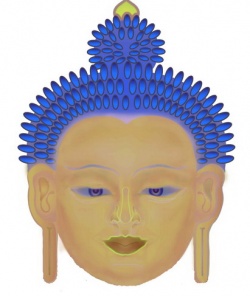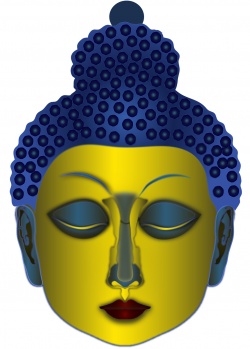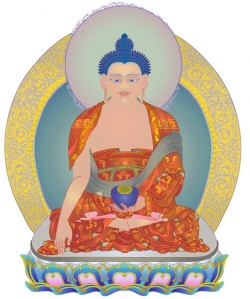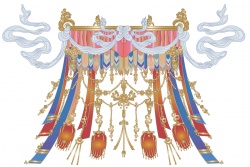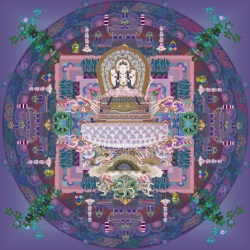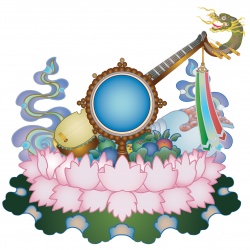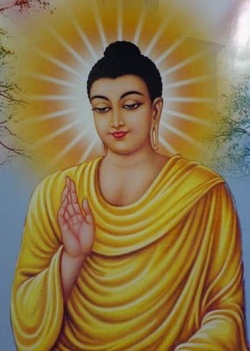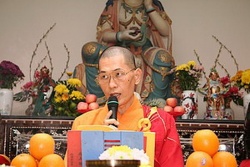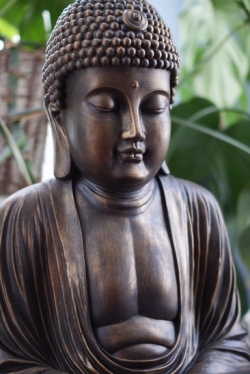Difference between revisions of "Householder"
| (2 intermediate revisions by one other user not shown) | |||
| Line 143: | Line 143: | ||
<poem> | <poem> | ||
| − | Householders & the {{Wiki|homeless}} | + | Householders & the {{Wiki|homeless}} ([[monastics]]) |
in mutual {{Wiki|dependence}} | in mutual {{Wiki|dependence}} | ||
both reach the true [[Dhamma]]: | both reach the true [[Dhamma]]: | ||
| Line 293: | Line 293: | ||
Other practices: Studying texts, receiving [[initiations]] and personal practice instructions from the [[teacher]]. | Other practices: Studying texts, receiving [[initiations]] and personal practice instructions from the [[teacher]]. | ||
[[File:6404598.jpg|thumb|250px|]] | [[File:6404598.jpg|thumb|250px|]] | ||
| − | + | {| style="text-align:center; border-bottom:2px solid blue; font-size:85%; margin:0.5em auto" cellspacing="0" cellpadding="8" | |
| − | + | |- | |
| + | | colspan=2 | | ||
| + | | style="background:yellow; color:blue; border-top:2px solid blue;" colspan=3 | <big>'''Lay Buddhist practices by school'''</big> | ||
| + | <!--- HEADERS ---> | ||
| + | |- | ||
| + | | colspan=2 | | ||
| + | | style="background:yellow;" | '''[[Theravada]]''' | ||
| + | | style="background:yellow; border-left:1px solid blue;" | '''[[Mahayana]]''' | ||
| + | | style="background:yellow; border-left:1px solid blue;" | '''[[Vajrayana]]''' | ||
| + | <!--- PROSTRATIONS ---> | ||
| + | |- | ||
| + | | style="border-top:2px solid blue; background:orange; color:blue; vertical-align:middle" rowspan=3 | <small>D<br />E<br />V<br />O<br />T<br />I<br />O<br />N<br />A<br />L</small> | ||
| + | | style="border-top:2px solid blue; background:orange; color:black" | '''[[Prostration (Buddhism)|Prostrations]]''' | ||
| + | | style="border-top:2px solid blue" | daily | ||
| + | | style="border-top:2px solid blue" | [[dokusan]]<ref>Kapleau (1989), p. 191.</ref> | ||
| + | | style="border-top:2px solid blue" | daily | ||
| + | <!--- CHANTING ---> | ||
| + | |- | ||
| + | | style="border-top:1px solid blue; background:orange; color:black" | '''[[Buddhist chant|Chanting]]''' | ||
| + | | style="border-top:1px solid blue" | daily | ||
| + | | style="border-top:1px solid blue" | regularly<ref>Daily chanting among Mahayana Buddhists can be found, for instance, among [[Nichiren]] and [[Pure Land]] practitioners.</ref> | ||
| + | | style="border-top:1px solid blue" | regularly | ||
| + | <!--- TAKING REFUGE ---> | ||
| + | |- | ||
| + | | style="border-top:1px solid blue; background:orange; color:black" | '''Take [[Refuge]]''' | ||
| + | | style="border-top:1px solid blue" | daily | ||
| + | | style="border-top:1px solid blue" | daily | ||
| + | | style="border-top:1px solid blue" | daily | ||
| + | <!--- 5 PRECEPTS ---> | ||
| + | |- | ||
| + | | style="border-top:2px solid blue; background:orange; color:blue; vertical-align:middle" rowspan=3 | <small>P<br />R<br />E<br />C<br />E<br />P<br />T<br />S</small> | ||
| + | | style="border-top:2px solid blue; background:orange; color:black;" | '''[[Five Precepts]]''' | ||
| + | | style="border-top:2px solid blue" | daily<ref>Examples in the [[Pali canon]] where the Buddha extols the practice of the Five Precepts included in the [[Dhammika Sutta]] and in the [[Sigalovada Sutta]].</ref> | ||
| + | | style="border-top:2px solid blue" | daily | ||
| + | | style="border-top:2px solid blue" | daily | ||
| + | <!--- 8 PRECEPTS ---> | ||
| + | |- | ||
| + | | style="border-top:1px solid blue; background:orange; color:black" | '''[[Five Precepts#Eight Precepts|Eight Precepts]]''' | ||
| + | | style="border-top:1px solid blue" | [[Uposatha]] | ||
| + | | style="border-top:1px solid blue" | Uposatha<br>(sometimes) | ||
| + | | style="border-top:1px solid blue" | Uposatha | ||
| + | <!--- BODHISATTVA VOWS ---> | ||
| + | |- | ||
| + | | style="border-top:1px solid blue; background:orange; color:black" | '''[[Bodhisattva vow]]s''' | ||
| + | | style="border-top:1px solid blue" | — | ||
| + | | style="border-top:1px solid blue" | daily | ||
| + | | style="border-top:1px solid blue" | daily | ||
| + | <!--- MEDITATION ---> | ||
| + | |- | ||
| + | | style="border-top:2px solid blue; background:orange; color:black" colspan=2 | '''[[Buddhist meditation|Meditation]]''' | ||
| + | | style="border-top:2px solid blue" | [[vipassanā]],<br />[[samatha]],<br />[[mettā]] | ||
| + | | style="border-top:2px solid blue" | samatha,<br />vipassanā,<br />[[zazen]],<br />[[shikantaza]],<br />[[kōan]],<br />nianfo,<br />mantras | ||
| + | | style="border-top:2px solid blue" | samatha,<br />vipassanā,<br />[[tonglen]], compassion, <br />tantric visualisations,<br />mantras, include tantric mantras | ||
| + | <!--- STUDYING TEXTS ---> | ||
| + | |- | ||
| + | | style="border-top:2px solid blue; background:orange; color:black" colspan=2 | '''Study [[Buddhist texts|scriptures]]''' | ||
| + | | style="border-top:2px solid blue" | Uposatha | ||
| + | | style="border-top:2px solid blue" | dependent upon tradition | ||
| + | | style="border-top:2px solid blue" | regularly | ||
| + | <!--- SUPPORTING MONKS & MONASTERIES ---> | ||
| + | |- | ||
| + | | style="border-top:1px solid blue; background:orange; color:black;" colspan=2 | '''Support [[Bhikkhu|monastics]]''' | ||
| + | | style="border-top:1px solid blue" | Uposatha | ||
| + | | style="border-top:1px solid blue" | regularly | ||
| + | | style="border-top:1px solid blue" | regularly | ||
| + | <!--- PILGRIMAGE ---> | ||
| + | |- | ||
| + | | style="border-top:1px solid blue; background:orange; color:black" colspan=2 | '''[[Buddhist pilgrimage|Pilgrimage]]''' | ||
| + | | style="border-top:1px solid blue" | several sites<ref>In the [[Mahaparinibbana Sutta]], the Buddha states that devotees can do pilgrimages to his birthplace, the place of his awakening, the place of his first teaching and the place of his death. Other sites have also been traditionally recognized by Theravada practitioners.</ref> | ||
| + | | style="border-top:1px solid blue" | varies | ||
| + | | style="border-top:1px solid blue" | varies | ||
| + | |} | ||
| + | {{reflist}} | ||
{{R}} | {{R}} | ||
[[Wikipedia:Householder (Buddhism)]] | [[Wikipedia:Householder (Buddhism)]] | ||
Latest revision as of 12:51, 4 April 2016
In English translations of Buddhist literature, householder denotes a variety of terms.
Most broadly, it refers to any layperson, and most narrowly, to a wealthy and prestigious familial patriarch.
In contemporary Buddhist communities, householder is often used synonymously with laity, or non-monastics.
The Buddhist notion of householder is often contrasted with that of wandering ascetics (Pāḷi: samaṇa; Sanskrit: śramaṇa) and monastics (bhikkhu and bhikkhuni), who would not live (for extended periods) in a normal house and who would pursue freedom from attachments to houses and families.
Lay disciples (upasaka and upasika) are householders and other laypersons who take refuge in the Triple Gem (the Buddha, his teaching and his community) and practice the Five Precepts.
In southeast Asian communities, lay disciples also give alms to monks on their daily rounds and observe weekly uposatha days.
In Buddhist thought, the cultivation of dana and ethical conduct will themselves refine consciousness to such a level that rebirth in one of the lower heavens is likely, even if there is no further Buddhist practice.
This level of attainment is viewed as a proper aim for laity.
In some traditional Buddhist societies, such as in Myanmar and Thailand, people transition between householder and monk and back to householder with regularity and celebration.
One of the evolving features of Buddhism in the West is the increasing dissolution of the traditional distinction between monastics and laity.
Theravada perspectives
In the Pali canon, householders received diverse advice from the Buddha and his disciples.
Some householders (who were also lay disciples) were even identified as having achieved nibbana.
Core householder practices include undertaking the Five Precepts and taking refuge in the Triple Gem.
In addition, the canon nurtures the essential bond between householders and monastics still apparent today in southeast Asian communities.
What is a householder?
In traditional Indian society, a householder (Sanskrit, grihastha) is typically a settled adult male with a family.
In the Buddhist Pali canon, various Pali words have been translated into the English word "householder" including agārika, gahapati, gahattha and gihin.
Vocations most often associated with householders in the Pali canon are those of guild foreman, banker and merchant (Pali, seṭṭhi) but other vocations are mentioned such as farmer and carpenter.
Other people in the canon who are sometimes identified as "householders" in contemporary translations are simply those individuals who dwelt in a home or who had not renounced "home life" (Pali, agārasmā) for "homelessness" (Pali, anagāriya).
Householder ethics
While there is no formal "householder discipline" or "code of ethics" in the ancient Buddhist Code of Ethics (Pali, Vinaya), the Sigalovada Sutta (DN 31) has been referred to as "the Vinaya of the householder" (gihi-vinaya).
This sutta includes:
- an enumeration of the Five Precepts
- an analysis of good-hearted (Pali: su-hada) friends
- a description of respectful actions for one's parents, teachers, spouse, friends, workers and religious guides.
Similarly, in the "Dhammika Sutta" (Sn 2.14), the Buddha articulates the "layman's rule of conduct" (Pali, gahatthavatta), as follows:
- the Five Precepts
- the Eight Precepts for Uposatha days
- support of one's parents
- engaging in fair business.
The Mahanama sūtra has been called the "locus classicus on the definition of upāsaka."
This sutra is preserved in five versions (two in Pali, three in Chinese) representing two different recensions, one in the Samyuktagama/Samyuttanikaya, the other in the Anguttaranikaya and in the Samyuktagama and further developed in the Abhidharmaskandha, one of the canonical books of the Sarvastivadin Abhidharma.
In this sutra the Buddha defines an upāsaka in terms of faith (śraddhā), morality (śīla), liberality (tyāga), and wisdom (prajñā), as follows:
He never lacks faith or is evil towards śramaṇas, brāhmaṇas, or deva, or māra, or brahmā. This is called the faith of an upāsaka."
- "Not to kill, not to steal, not to seduce, not to lie, and not to drink liquor, etc. This is called the morality of an upāsaka".
- "It is a rule (dharma) for an upāsaka that he should abandon stinginess. As for all living beings, without exception, stinginess, and envy are destroyed by him.
Therefore, his mind should be devoid of stinginess and envy, and he should produce thoughts of liberality and personally donate, tirelessly. This is called 'possessed of liberality.'"
- "An upāsaka knows suffering according to reality, knows the collection of suffering according to reality, knows the extinction of suffering according to reality, and knows the path to the extinction of suffering according to reality. He understands with certainty. This is called 'possessed of wisdom.'"
Some early schools, particularly the Sautrāntika, allowed for aparipūrṇa-upāsaka (partial lay vow holders), who took anywhere from one to four of the śīla observances.
Other suttas in the canon likewise underline keeping the preceptsg virtuous friends, homage to one's benefactors and earning one's wealth honestly.
Elsewhere in the Sutta Pitaka the Buddha provides moral instruction to householders and their family members on how to be good parents, spouses and children.
Buddha's advice to Buddhist laywomen is contained mostly in the Anguttara Nikaya 8:49; IV 269-71. His advice was as follows:
- Be capable at one's work
- Work with diligence and skill
- Manage domestic help skillfully (if relevant) and treat them fairly
- Perform household duties efficiently
- Be hospitable to one's husband's parents and friends
- Be faithful to one's husband; protect and invest family earnings
- Discharge responsibilities lovingly and conscientiously; accomplish faith (faith in the possibility of enlightenment, and of the enlightenment of the Buddha.)
- Accomplish moral discipline (observe/practise the five precepts.)
- Practise generosity (cultivate a mind free from stinginess or avarice; delight in charity, giving and sharing.)
- Cultivate wisdom (Perceive the impermanence of all things.).
The Buddha also gave advice on householders' financial matters. In the Anguttara Nikaya (4.61; II 65-68) it is said that the Buddha stated that there are four worthy ways in which to spend one's wealth:
- On the everyday maintenance of the happiness of oneself and one's family (as well as any employees, friends and co-workers);
- On providing insurance (against losses from fire, floods, unloved heirs and misfortune generally);
- By making offerings to relatives, guests, ancestors ( offerings to ancestors are traditionally made, in a respectful Halloween type ritual, throughout Buddhist countries on Ulumbana, in the eighth lunar month – around October. Food offerings and good deeds are done in order to relieve the sufferings of hungry ghosts and to help rescue one's ancestors from the lower realms, to secure rebirth for them in higher realms. Many people visit cemeteries to make offerings to departed ancestors), the Monarch and the Devas (note that worshipping Devas will not bring you closer to enlightenment but it may give you some kind of material advantage);
- By providing alms to monks and nuns who are devoted to the attainment of Nibbana. In the Digha Nikaya (III) the Buddha is said to have advised Sigala, a young man, that he should spend one fourth of his income on daily expenses, invest half in his business and put aside one fourth as insurance against an emergency.
Lay-monastic reciprocity
Some suttas suggest that Buddhist renunciates are best going it alone.
Many others celebrate and provide instruction for a vital reciprocity between householders and monastics.
For instance, in the Khuddaka Nikaya, the Buddha articulates that "brahmins and householders" (Pali, brāhmanagahapatikā) support monks by providing monks with robes, alms food, lodgings and medicine while monks teach brahmins and householders the Dhamma.
In this sutta, the Buddha declares:
Householders & the homeless (monastics)
in mutual dependence
both reach the true Dhamma:
the unsurpassed safety from bondage.
Householders & future lives
In the Pali canon, the pursuit of Nibbana (Skt: Nirvana) within this lifetime usually starts with giving up the householder life.
This is due to the householder life's intrinsic attachments to a home, a spouse, children and the associated wealth necessary for maintaining the household.
Thus, instead of advising householders to relinquish these and all attachments as a prerequisite for the complete liberation from samsara in this lifetime, the Buddha instructed householders on how to achieve "well-being and happiness" (hita-sukha) in this and future lives in a spiritually meaningful way.
In Buddhism, a householder's spiritual path is often conceived of in terms of making merit (Pali: puñña).
The primary bases for meritorious action in Buddhism are generosity (dāna), ethical conduct (sīla) and mental development (bhāvanā). Traditional Buddhist practices associated with such behaviors are summarized in the table below.
| FAITH (Saddhā) | GIVING (Dāna) | VIRTUE (Sīla) | MIND (Bhāvanā) | WISDOM (Paññā) |
|
Charity · |
||||
|
Based on: Dighajanu Sutta, Velama Sutta, Dhammika Sutta. |
||||
Householders & Nibbana
The Anguttara Nikaya (AN 6.119 and AN 6.120) identifies 19 householders (gahapati) who have "attained perfection" or, according to an alternate translation, "attained to certainty" (niṭṭhamgata) and "seen deathlessness, seen deathlessness with their own eyes" (amataddaso, amataṃ sacchikata).
These householders are endowed (samannāgato) with six things (chahi dhammehi):
- unwavering faith (aveccappasādena) in the Buddha
- unwavering faith in the Teaching (dhamma)
- unwavering faith in the Community (sangha)
- noble moral discipline (ariyena sīlena)
- noble knowledge (ariyena ñānena)
- noble release (ariyāya vimuttiyā)
While some interpret this passage to indicate that these householders have attained arahantship, others interpret it to mean they have attained at least "stream entry" (sotapatti) but not final release. The para-canonical Milindapañha adds:
- "...[F]or a householder who has attained arahantship: either, that very day, he goes forth into homelessness or he attains final Nibbāna. That day is not able to pass without one or other of these events taking place." (Miln. VII, 2)
Attaining the state of non-returner is portrayed in the early texts as the ideal goal for laity.
Prominent householders in the Pali canon
The following are examples of individuals who are explicitly identified as a "householder" (Pali, gahapati) in multiple suttas:
- Anathapindika, is referenced for instance in AN 1.14.249 as "the householder Sudatta, the foremost lay devotee."
- Citta, referenced for instance in AN 1.14.250 as "the [foremost] householder for explaining the Teaching." In SN 17.23, Citta is one of two male lay disciples identified for emulation by the Buddha.
- Nakulapita and Nakulamata, referenced for instance in AN 1.14.257 and AN 1.14.266, respectively, as "the best confident" and the foremost "for undivided pleasantness."
Other individuals who are not explicitly identified in the suttas as "householder" but who, by the aforementioned broader critera, might be considered a householder include:
- Ghatikara was a potter in the time of Buddha Kassapa. He was an Anagami and the chief supporter of Buddha Kassapa (MN 81).
Mahayana perspectives
The Sigalovada Sutta has a parallel Chinese text.
There are few differences between the Pali and Chinese versions.
Further discussion of householder duties is found in the fourteenth chapter of the Sutra on Upasaka Precepts.
Dogen recommended that householders meditate at least five minutes each day.
In the Zen tradition, Vimalakīrti and Páng Yùn were prominent householders/laypersons who achieved enlightenment.
Vajrayana perspectives
The Vajrayana tradition has produced many prominent householders, from Marpa to Dromton Gyalwa Jungne, the heart son of Atisha; Padmasambhava to mention a few.
The ngakpa is an ordained Tantrica, sometimes a householder with certain vows (dependent upon Lama and Lineage) that make them the householder equivalent of an ordained bikshu.
The path of a Tantrica or Ngakpa (mas.) or Ngakma (fem.) is a rigorous discipline whereby one "enjoys the sense-fields' as a part of one's practice. A practitioner utilizes the whole of the phenomenal world as one's path.
Marrying, raising children, working jobs, leisure, art, play etc. are all means to realize the enlightened state or Rigpa, non-dual awareness.
A Ngakpa or Ngakma does not need to be a householder particularly, but is still encouraged to 'immerse oneself' in the world at large.
The Ngakpa tradition is unfortunately not widely known due to the prominence of monastic Buddhism (especially in Tibetan Buddhism).
At times the Ngakpa/ma path is even disparged by those who misunderstand the symbolism and structure of the path.
As such, we can see the prominence of householders in the Vajrayana tradition.
One can, however, be a householder without taking the vows of a Ngakpa. Simply holding the five precepts, bodhisattva vows and the tantric vows while practising diligently can result in enlightenment.
Contemporary Buddhist householder practices
Below common contemporary lay Buddhist practices are summarized.
Some of these practices — such as taking Refuge and meditating — are common to all major schools. Other practices — such as taking the Eight Precepts or the Bodhisattva Vows — are not pan-Buddhist.
Theravada practices
For Theravada Buddhists, the following are practiced on a daily and weekly basis:
Daily practice: prostrations to the Triple Gem, taking refuge in the Triple Gem, taking the Five Precepts, chanting other verses, meditating, giving and sharing (Pali: dana).
Special day practices (Uposatha): practicing the Eight Precepts, studying Buddhist scriptures, visiting and supporting Buddhist monks, visiting and supporting Buddhist monasteries.
Other practices: undertaking a pilgrimage.
Mahayana practices
Daily practices: Prostrations to the Triple Gem, taking refuge in the Triple Gem, taking the Five Precepts, chanting sutras and the Buddha's name, meditating, cultivating compassion and bodhichitta.
Special day practices: Upholding the eight precepts, listening to teachings, supporting Sangha, repentance, performing offering ceremonies to sentient beings
Other practices: Bodhisattva vows
Vajrayana practices
Daily practices: Prostrations, refuge, cultivating compassion and bodhichitta, bodhisattva vows, tantric vows (if applicable), meditation in the form of Tantric sadhanas (if applicable), purification techniques, recitation of mantras
Special day practices: 8 preceptsg to teachings, offering ceremonies.
Other practices: Studying texts, receiving initiations and personal practice instructions from the teacher.
| Lay Buddhist practices by school | ||||
| Theravada | Mahayana | Vajrayana | ||
| D E V O T I O N A L |
Prostrations | daily | dokusan[1] | daily |
| Chanting | daily | regularly[2] | regularly | |
| Take Refuge | daily | daily | daily | |
| P R E C E P T S |
Five Precepts | daily[3] | daily | daily |
| Eight Precepts | Uposatha | Uposatha (sometimes) |
Uposatha | |
| Bodhisattva vows | — | daily | daily | |
| Meditation | vipassanā, samatha, mettā |
samatha, vipassanā, zazen, shikantaza, kōan, nianfo, mantras |
samatha, vipassanā, tonglen, compassion, tantric visualisations, mantras, include tantric mantras | |
| Study scriptures | Uposatha | dependent upon tradition | regularly | |
| Support monastics | Uposatha | regularly | regularly | |
| Pilgrimage | several sites[4] | varies | varies | |
Footnotes
- ↑ Kapleau (1989), p. 191.
- ↑ Daily chanting among Mahayana Buddhists can be found, for instance, among Nichiren and Pure Land practitioners.
- ↑ Examples in the Pali canon where the Buddha extols the practice of the Five Precepts included in the Dhammika Sutta and in the Sigalovada Sutta.
- ↑ In the Mahaparinibbana Sutta, the Buddha states that devotees can do pilgrimages to his birthplace, the place of his awakening, the place of his first teaching and the place of his death. Other sites have also been traditionally recognized by Theravada practitioners.

